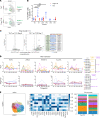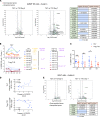The effect of low-dose IL-2 and Treg adoptive cell therapy in patients with type 1 diabetes
- PMID: 34324441
- PMCID: PMC8492314
- DOI: 10.1172/jci.insight.147474
The effect of low-dose IL-2 and Treg adoptive cell therapy in patients with type 1 diabetes
Abstract
BACKGROUNDA previous phase I study showed that the infusion of autologous Tregs expanded ex vivo into patients with recent-onset type 1 diabetes (T1D) had an excellent safety profile. However, the majority of the infused Tregs were undetectable in the peripheral blood 3 months postinfusion (Treg-T1D trial). Therefore, we conducted a phase I study (TILT trial) combining polyclonal Tregs and low-dose IL-2, shown to enhance Treg survival and expansion, and assessed the impact over time on Treg populations and other immune cells.METHODSPatients with T1D were treated with a single infusion of autologous polyclonal Tregs followed by one or two 5-day courses of recombinant human low-dose IL-2 (ld-IL-2). Flow cytometry, cytometry by time of flight, and 10x Genomics single-cell RNA-Seq were used to follow the distinct immune cell populations' phenotypes over time.RESULTSMultiparametric analysis revealed that the combination therapy led to an increase in the number of infused and endogenous Tregs but also resulted in a substantial increase from baseline in a subset of activated NK, mucosal associated invariant T, and clonal CD8+ T cell populations.CONCLUSIONThese data support the hypothesis that ld-IL-2 expands exogenously administered Tregs but also can expand cytotoxic cells. These results have important implications for the use of a combination of ld-IL-2 and Tregs for the treatment of autoimmune diseases with preexisting active immunity.TRIAL REGISTRATIONClinicalTrials.gov NCT01210664 (Treg-T1D trial), NCT02772679 (TILT trial).FUNDINGSean N. Parker Autoimmune Research Laboratory Fund, National Center for Research Resources.
Keywords: Autoimmunity; Clinical Trials; Diabetes; Immunotherapy; T cells.
Conflict of interest statement
Figures







References
Publication types
MeSH terms
Substances
Associated data
Grants and funding
LinkOut - more resources
Full Text Sources
Other Literature Sources
Medical
Molecular Biology Databases
Research Materials

